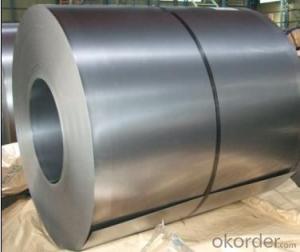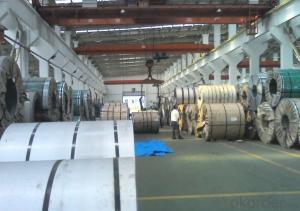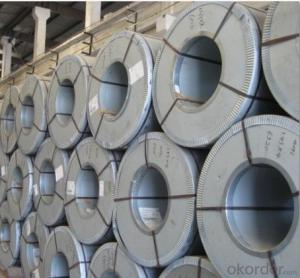304 SERIOUS HOT ROLLED STAINLESS STEEL COILS/SHEETS
- Loading Port:
- Shanghai
- Payment Terms:
- TT OR LC
- Min Order Qty:
- 100 m.t.
- Supply Capability:
- 20000 m.t./month
OKorder Service Pledge
OKorder Financial Service
You Might Also Like
Quick Details
| Grade: | 2B | Standard: | JIS,AISI,GB | Length: | as customers' requested |
| Thickness: | 2.5mm;3.0mm;4.0mm or as required | Width: | 485mm,510mm,600mm or as required | Place of Origin: | Shanxi China (Mainland) |
| Brand Name: | CNBM | Model Number: | 201 | Type: | Coil |
| Application: | Decoration,Boiler Plate,Chemical Industry,Container plate,ship | Certification: | SGS,ISO | Color: | natural color |
| Available Finish: | 2B/BA/8K/No.4/SB/HL | Edge: | slit edge and mill edge | Features: | accurate dimensions |
| Manufacture technology: | cold drawn,pickling, hot rolled and cold rolled | DDQ: | slivery bright surface | Quality: | high quality Hot rolled stainless steel coil 201 |
| Stock: | Always in stock | Item: | Hot rolled stainless steel coil 201 |
Packaging & Delivery
| Packaging Detail: | Standard export packing or as customer's requirement Hot rolled stainless steel coil 201 |
| Delivery Detail: | In 15 days |
Specifications
Hot rolled stainless steel coil 201
Width:485mm,510mm,600mm or as required
Thickness: 2.5mm;3.0mm;4.0mm or as required
Product Description
Stainless steel coil; stainless steel cold rolled coil;201 stainless steel coil; stainless steel coil
A. stainless steel coil
B. with competitive prices and fast delivery
C. High quality
Tisco 201 stainless steel coil
Thickness: 2.5mm;3.0mm;4.0mm or as required
Width: 485mm,510mm,600mm or as required
Length: As required
Material:201
201 stainless steel coil chemical composition
201 stainless steel coil | ||||||||
Grade | Chemical composition | |||||||
C | Si | Mn | P | S | Ni | N | Cr | |
% | % | % | % | % | % | % | % | |
201 | ≤0.15 | ≤0.75 | 5.5~7.50 | ≤0.060 | ≤0.030 | 3.50~5.50 | ≤0.25 | 16.00-18.00 |
201 stainless steel coil physical property
Physical Property | ||||
density | Strength of extension | yield strength | elongation | modulus of elasticity |
g/cm³ | psi | psi | % | psi |
7.93 | 100000-180000 | 50000-15000 | 55-60 | 29000000 |
Item | CNBM 201 stainless steel coil |
Technical | Hot rolled and cold rolled |
Standard | ASTM A240,GB/T3280-2007,JIS4304-2005,ASTM A167,EN10088-2-2005,GB/T3280-2007,EN10095-99,JIS4312,etc |
Material | 201,202,304,304L,309S,310S,316,316L,316Ti,430 |
Surface | NO.1,2b,4K,8k,HL,mirror finish |
Thickness | 0.3-100mm |
Width | 500-2000mm |
Price term | FOB,CFR,CIF |
Application | Stainless steel coil applies to construction field, ships building industry, petroleum, chemical industries, war and electricity industries, food processing and medical industry, boiler heat exchanger, machinery and hardware fields. Stainless steel coil can be made according to the customer’s requirements. |
Contact | If you have any question, please feel free to contact me. |
- Q:Can stainless steel strips be bent or folded without cracking?
- Stainless steel strips possess the ability to be bent or folded without experiencing any cracking. The exceptional ductility and formability of stainless steel allow for effortless manipulation into diverse shapes without sustaining any fractures. However, it is crucial to consider the recommended bend radius, which pertains to the tightness of the bend, in order to prevent any potential damage or cracking to the material. Furthermore, the bendability of the stainless steel strip can also be influenced by its type and thickness, with thinner strips generally exhibiting greater flexibility. In summary, if appropriate techniques and parameters are adhered to, stainless steel strips can be subjected to bending or folding processes without encountering any cracking.
- Q:Can 111 stainless steel strips be formed into complex shapes?
- Yes, 111 stainless steel strips can be formed into complex shapes. Stainless steel is a versatile material that can be easily bent, molded, and shaped to create intricate designs and structures.
- Q:What are the different types of packaging options for stainless steel strips?
- There are several different types of packaging options available for stainless steel strips, depending on the specific requirements and preferences of the customer or manufacturer. 1. Coils: Stainless steel strips can be packaged in coil form, where the strips are wound tightly together to form a continuous roll. This type of packaging is commonly used for bulk transportation and storage, as it allows for easy handling and efficient use of space. 2. Bundles: Another common packaging option is to bundle the stainless steel strips together using straps or bands. This type of packaging is suitable for smaller quantities or when the strips need to be protected individually. Bundles can be wrapped in protective materials such as plastic or cardboard for additional safety during transportation. 3. Pallets: Stainless steel strips can also be packaged on pallets, especially when they are being shipped in larger quantities. The strips are placed on a sturdy wooden or plastic pallet and secured with strapping or stretch wrap. This type of packaging ensures stability during transportation and makes it easier to load and unload the strips using forklifts or pallet jacks. 4. Custom packaging: Some customers may require custom packaging options for their stainless steel strips. This can include special labeling, barcoding, or additional protective measures such as foam inserts or crates. Custom packaging is often used when the stainless steel strips are being sent to specific industries or for specialized applications where extra care is needed. Overall, the choice of packaging option for stainless steel strips depends on factors such as the quantity, transportation requirements, and desired level of protection. It is important to consider the specific needs and preferences of the customer or manufacturer to ensure that the packaging choice meets their requirements and ensures the safe delivery of the stainless steel strips.
- Q:Can stainless steel strips be used in the renewable energy industry?
- The renewable energy industry can indeed utilize stainless steel strips. Stainless steel is a remarkably versatile and durable material that provides exceptional resistance to corrosion and longevity. As a result, it is well-suited for a wide range of applications within renewable energy systems. One prevalent application of stainless steel strips in the renewable energy sector is in the production of solar panels. These strips are often employed as reflectors or for bonding solar cells together. This is due to their ability to withstand weathering and moisture. Additionally, stainless steel strips can serve as framing and mounting structures in solar panel installations, offering a robust and reliable support system. Another use of stainless steel strips in the renewable energy field is in the construction of wind turbines. These strips are commonly utilized in the manufacturing of turbine blades, which require materials capable of withstanding high winds, corrosion, and fatigue. Stainless steel's strength and resistance to corrosion make it an ideal choice for this purpose, ensuring the turbines' longevity and performance. Apart from solar panels and wind turbines, stainless steel strips can also find applications in other renewable energy technologies such as hydropower, geothermal, and biomass systems. They can be employed for various purposes, including heat exchangers, piping, and structural components, where their resistance to corrosion and mechanical properties offer significant advantages. In conclusion, stainless steel strips provide numerous advantages that make them well-suited for use in the renewable energy industry. Their durability, corrosion resistance, and versatility make them an excellent choice for various applications, enabling efficient and sustainable generation of renewable energy.
- Q:How do stainless steel strips perform in high-temperature environments?
- High-temperature environments are where stainless steel strips truly shine, thanks to their exceptional performance. The key to their success lies in their unique composition, which boasts a high percentage of chromium. This chromic element forms a protective layer of chromium oxide on the surface of the stainless steel, effectively safeguarding it from corrosion and oxidation, even when exposed to elevated temperatures. When faced with high-temperature conditions, stainless steel strips exhibit remarkable heat resistance while maintaining their mechanical properties. They are capable of enduring thermal cycling without experiencing significant deformation, thereby ensuring their dimensional stability and structural integrity. This remarkable characteristic renders them suitable for a broad range of applications that necessitate continuous exposure to high temperatures, such as heat exchangers, exhaust systems, and industrial furnaces. Moreover, stainless steel strips retain their strength and hardness when subjected to elevated temperatures, guaranteeing dependable performance in demanding circumstances. They possess excellent resistance to creep and stress rupture, allowing them to withstand prolonged exposure to high temperatures without succumbing to deformation or failure. These attributes render them highly reliable in critical applications where safety and durability are of utmost importance. In addition, stainless steel strips possess low thermal expansion coefficients, meaning they expand minimally even when subjected to extreme temperatures. This property plays a crucial role in minimizing thermal stresses and preventing warping or distortion of the material, thereby ensuring its dimensional stability over time. In conclusion, stainless steel strips are an outstanding choice for high-temperature environments due to their corrosion resistance, heat resistance, mechanical strength, and dimensional stability. Their exceptional performance in these conditions has made them the preferred material for various industries, where they consistently rise to the challenges posed by extreme temperatures.
- Q:Can stainless steel strips be used in the chemical industry?
- Yes, stainless steel strips can be used in the chemical industry. Stainless steel is known for its excellent corrosion resistance, which makes it an ideal choice for use in environments where there are chemicals present. It can withstand exposure to various chemicals, acids, and alkalis, making it suitable for applications such as chemical storage tanks, pipes, valves, and fittings. Additionally, stainless steel strips are durable, easy to clean, and maintain their strength and integrity even in harsh chemical environments. Therefore, they are widely used in the chemical industry for their reliability and longevity.
- Q:Can stainless steel strips be used in medical implants?
- Yes, stainless steel strips can be used in medical implants. Stainless steel is a common material used in the medical industry due to its excellent corrosion resistance, durability, and biocompatibility. It is often used in the production of surgical instruments, orthopedic implants, and other medical devices. Stainless steel strips can be fabricated into various shapes and sizes to meet the specific requirements of different medical implants. The material's corrosion resistance ensures that it can withstand exposure to bodily fluids and other harsh environments within the human body, reducing the risk of implant failure or infection. Additionally, stainless steel has been extensively researched and documented for its biocompatibility, meaning it is well-tolerated by the human body and does not cause adverse reactions. This makes stainless steel a safe and reliable choice for medical implants, as it minimizes the risk of allergic reactions or long-term complications. However, it is important to note that the selection of materials for medical implants ultimately depends on the specific application and the patient's unique needs. Consultation with medical professionals and adherence to regulatory guidelines is crucial in determining the most suitable material for each individual case.
- Q:Are stainless steel strips resistant to UV radiation?
- Yes, stainless steel strips are generally resistant to UV radiation. Stainless steel is known for its excellent corrosion resistance, and this includes resistance to the damaging effects of UV radiation. The chromium content in stainless steel forms a protective oxide layer on its surface, which helps to prevent UV radiation from causing any significant damage or degradation to the material. Additionally, stainless steel is often used in outdoor applications and environments where it is exposed to sunlight and UV radiation, such as architectural structures, automotive parts, and marine equipment, further indicating its resistance to UV radiation. However, it is important to note that the specific resistance of stainless steel strips to UV radiation may vary depending on the grade and quality of the stainless steel used, as well as the duration and intensity of the UV exposure.
- Q:How do stainless steel strips resist intergranular corrosion?
- Stainless steel strips resist intergranular corrosion primarily due to the presence of chromium in their composition. Chromium forms a protective oxide layer on the surface of the steel, which acts as a barrier against corrosive elements. This oxide layer is self-repairing, ensuring the strips retain their corrosion resistance even if damaged. Additionally, stainless steel strips are often alloyed with other elements such as molybdenum, which further enhances their resistance to intergranular corrosion.
- Q:Are stainless steel strips suitable for architectural cladding?
- Yes, stainless steel strips are suitable for architectural cladding. Stainless steel is highly durable, corrosion-resistant, and has a sleek and modern appearance. It can be used to create a variety of design elements for architectural cladding, such as panels, screens, and facades. Additionally, stainless steel is easy to maintain and can withstand harsh weather conditions, making it an ideal choice for long-lasting and visually appealing architectural cladding.
1. Manufacturer Overview |
|
|---|---|
| Location | |
| Year Established | |
| Annual Output Value | |
| Main Markets | |
| Company Certifications | |
2. Manufacturer Certificates |
|
|---|---|
| a) Certification Name | |
| Range | |
| Reference | |
| Validity Period | |
3. Manufacturer Capability |
|
|---|---|
| a)Trade Capacity | |
| Nearest Port | |
| Export Percentage | |
| No.of Employees in Trade Department | |
| Language Spoken: | |
| b)Factory Information | |
| Factory Size: | |
| No. of Production Lines | |
| Contract Manufacturing | |
| Product Price Range | |
Send your message to us
304 SERIOUS HOT ROLLED STAINLESS STEEL COILS/SHEETS
- Loading Port:
- Shanghai
- Payment Terms:
- TT OR LC
- Min Order Qty:
- 100 m.t.
- Supply Capability:
- 20000 m.t./month
OKorder Service Pledge
OKorder Financial Service
Similar products
New products
Hot products
Hot Searches
Related keywords





























